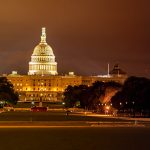The first rotational Bomber Task Force (BTF) mission involving B-1B Lancer strategic bombers to Japan had a rocky start following an unplanned landing on a commercial runway.
In mid-April, at least two B-1Bs from the 9th Expeditionary Bomb Squadron at Dyess Air Force Base (AFB), Texas, were deployed to Japan as part of a BTF mission to the island nation. Dyess Air Force Base announced that the aircraft are currently participating in “joint and combined operations” with U.S. allies and partners in the Indo-Pacific region, operating from Misawa Air Base in the Aomori prefecture north of Japan’s main island of Honshu.
However, on Tuesday evening, one of the B-1 Lancers was forced to make an emergency landing at Misawa Air Base.
According to a report from Stars and Stripes though the aircraft suffered no damage and no one was injured, it “shut down a shared runway and canceled commercial flights” at Misawa Airport, resulting in a “sharp rebuke from local officials, who demanded strong safety measure from the Air Force and Japan’s Ministry of Defense.”
What We Know About the B-1B Lancer Accident
Though the reasons are unknown, it was reported that a decision was made to keep the aircraft on the runway after it landed, resulting in its approximately ninety-minute closure. That forced a flight from Tokyo’s Haneda Airport, with 200 passengers on board, to return without landing.
“The B-1B paused on the runway as a precautionary measure to allow first responders to inspect the aircraft before clearing it to taxi off the runway,” Captain Leeroy Stark, spokesperson for the 35th Fighter Wing at Misawa Air Base, told Stars and Stripes.
It is unclear if another flight arrived with the passengers, but the delay elicited a response from officials from Misawa city and Aomori prefecture.
“We believe that the incident caused anxiety among the people of the prefecture, where Misawa Air Base is located. We deeply regret that it occurred despite our request for civil stability and safety measures made on April 18,” the Aomori prefectural government wrote in a letter, noting the day the B-1B bombers arrived in Japan.
City officials also requested that the cause of the incident be disclosed while greater safety measures are implemented to prevent its recurrence.
A Reminder of the B-1B Lancer Accident at Ellsworth AFB
Though the Lancer appears to have sustained no significant damage, this week’s incident reminds us that another B-1B crashed while landing at Ellsworth AFB, South Dakota, in early 2024.
The crew was forced to eject, but the bomber was destroyed, and the single runway at the base was shut down for nearly a month.
The U.S. Air Force redeployed some of the 28th Bomb Wing’s Lancers to Dyess AFB. An investigation revealed that a lack of discipline and bad weather were to blame for the crash that resulted in the total loss of the $456 million bomber.
As previously reported, this year started with a string of aviation mishaps that included the deadly collision of a U.S. Army UH-60 Blackhawk with an American Airlines jetliner in Washington, D.C. in February, while a B-52 from Barksdale AFB, Louisiana, “landed without incident” at Offutt AFB, Nebraska, after an in-flight emergency just a day later.
In January, a Lockheed Martin F-22A Raptor air superiority fighter was forced to make an emergency landing at Kadena Air Base on Okinawa, Japan.
A week later, a Lockheed Martin F-35A Lightning II conventional takeoff and landing (CTOL) fifth-generation multirole aircraft suffered an “in-flight malfunction” at Eielson AFB, Alaska, crashing to the ground and exploding.
About the Author: Peter Suciu
Peter Suciu has contributed over 3,200 published pieces to more than four dozen magazines and websites over a thirty-year career in journalism. He regularly writes about military hardware, firearms history, cybersecurity, politics, and international affairs. Peter is also a Contributing Writer for Forbes and Clearance Jobs. He is based in Michigan. You can follow him on Twitter: @PeterSuciu. You can email the author: [email protected].
Image Credit: Shutterstock/ DLeng.
















